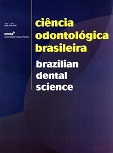Efeito de diferentes técnicas de acabamento e polimento sobre a rugosidade superficial de resinas acrílicas utilizadas para restaurações provisórias
DOI:
https://doi.org/10.14295/bds.2009.v12i1.248Abstract
Considerando a importância da lisura superficial das restaurações provisórias, o objetivo desse trabalho foi de avaliar o efeito de diferentes métodos de acabamento e polimento sobre a rugosidade superficial de 05 resinas acrílicas autopolimerizáveis(Dencor®, Dencrilay®, Duralay®, Instatemp® e Vipi Cor®). Um total de 200 corpos de prova foram confeccionados, sendo 40 corpos de prova para cada resina, que foram obtidos a partir de uma matriz bipartida com um
molde cilíndrico de aço inoxidável de 10 mm de diâmetro e 3mm de profundidade. Cada material foi proporcionado de acordo com a recomendação de seu fabricante, inseridos no molde na fase plástica e após polimerização, todos os
espécimes foram armazenados em umidificador à 37ºC por 24 horas. Dez espécimes de cada resina foram submetidos a cada um dos seguintes procedimentos: a) sof-lex + branco de espanha; b) sof-lex + selante de superfície; c) pedra-pomes
+ branco de espanha; d) pedra-pomes + selante de superfície. Em seguida, a rugosidade superficial média (Ra medida em μm) foi aferida e registrada pelo rugosímetro (SJ-301, Mitutoyo – Japan) para posterior comparação entre os grupos.
Os dados coletados foram submetidos à análise estatística através de testes paramétricos de “Kolmogorov-Smirnov” e análise de variância com nível de significância de 5%. Os resultados evidenciaram diferença estatisticamente significante em relação à rugosidade apenas entre a resina Instatemp® (menos rugosa) e a resina Vipi-Cor® (mais rugosa). No entanto, ao comparar os procedimentos de acabamento e polimento independente do tipo de resina acrílica, os dados evidenciaram diferenças numéricas, porém sem diferença estatisticamente significativa. Dentro das limitações desse estudo, concluiu-se que as resinas acrílicas apresentaram comportamento diferente em relação à rugosidade superficial média frente aos métodos de acabamento e polimento.
Downloads
Downloads
Published
How to Cite
Issue
Section
License
Brazilian Dental Science uses the Creative Commons (CC-BY 4.0) license, thus preserving the integrity of articles in an open access environment. The journal allows the author to retain publishing rights without restrictions.
=================




























